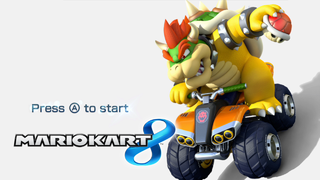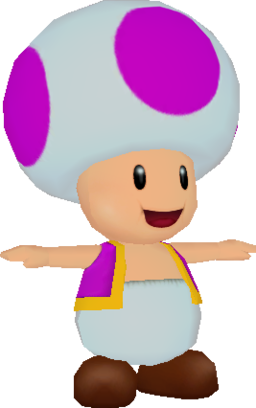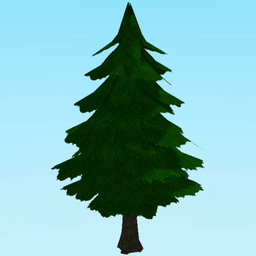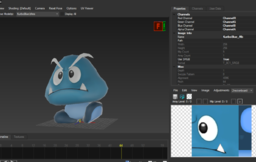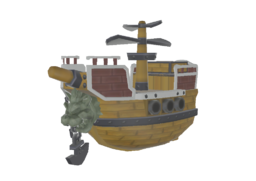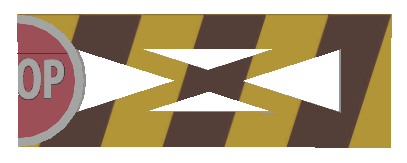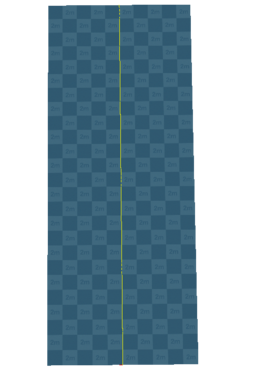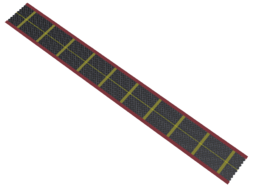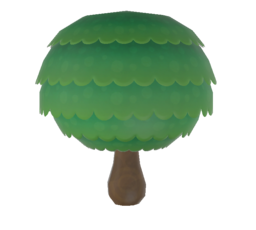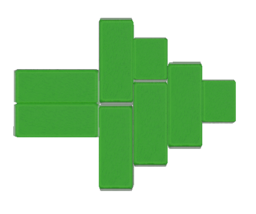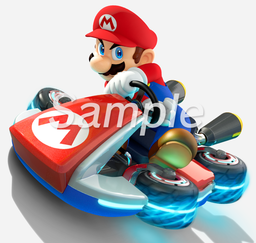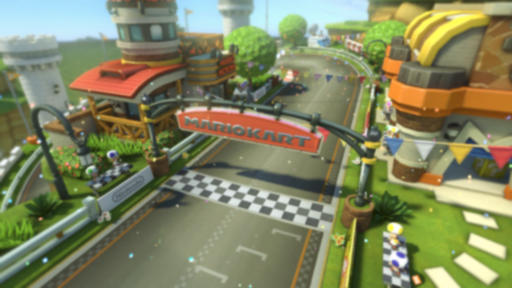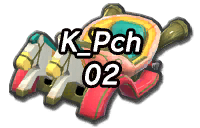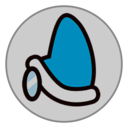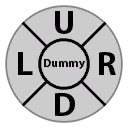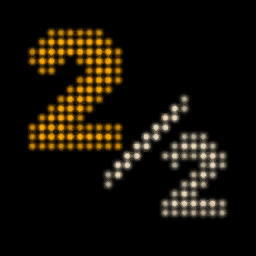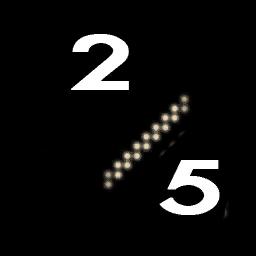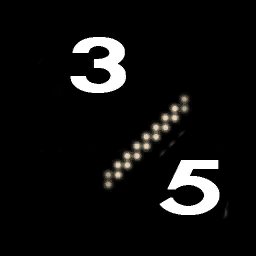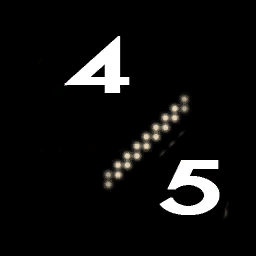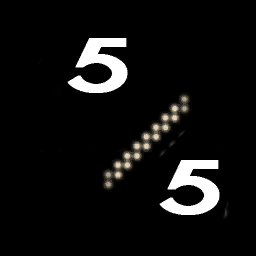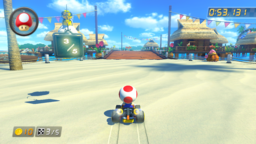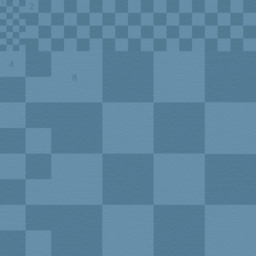If you appreciate the work done within the wiki, please consider supporting The Cutting Room Floor on Patreon. Thanks for all your support!
Mario Kart 8
| Mario Kart 8/de |
|---|
|
Entwickler: Nintendo EAD,
Bandai Namco
|
Mario Kart 8 bietet neue Anti-Schwerkraft-Physik und die Wiederkehr von Fallschirmen sowie Unterwasserrennen aus dem vorherigen Spiel. Desweiteren: Koopalinge.
The game was later ported to the Nintendo Switch as Mario Kart 8 Deluxe. While the base game is largely the same, it did receive a number of balance tweaks and new features, such as the ability to hold two items at once, a revamped Battle Mode with new courses, six new playable characters (including the Inklings from Splatoon), and three new vehicles.
| To do: |
Contents
- 1 Sub-Pages
- 2 Unbenutzte Strecken
- 3 Unbenutzte Modelle
- 3.1 Pink-farbener Toad
- 3.2 Früchtekorb
- 3.3 N64-Baum
- 3.4 Snowless Mount Wario Tree
- 3.5 Yellow Pylon
- 3.6 Unused Pipes not Housing Piranha Plants
- 3.7 Start Flag
- 3.8 Blue Goomba
- 3.9 Airships
- 3.10 Early Balloon
- 3.11 Audience Group
- 3.12 Flat Grass Model
- 3.13 Early Flag
- 3.14 Early Trolley Gates
- 3.15 Early Tick-Tock Clock Gears
- 3.16 Early Iceberg
- 3.17 Moving Roads
- 3.18 Music Piranha Plant
- 3.19 Wii Tree
- 3.20 Early SNES Rainbow Road Arrow
- 3.21 Unused Koopa
- 3.22 Early Pitcrew Toad
- 3.23 Rotation Road
- 3.24 Unused Skyboxes
- 4 Unbenutzte Grafiken
- 5 Unbenutzte/Test-Items
- 6 Disabled Glider Closing
- 7 Shy Guy Bazaar
- 8 Regionale Unterschiede
- 9 Versionsunterschiede
- 10 Totakas Lied
- 11 Oddities
- 12 Trivia der Charakter-Audiodateien
- 13 Interner Projektname
Sub-Pages
| Prerelease Info (untranslated) |
| Kiosk Demo (April 4th, 2016) |
Unbenutzte Strecken
Test
Diese unbenutzte Strecke besitzt die ID 0x01. Es ist eine Kopie von Marios Piste aus dem Blumen-Cup, allerdings ohne Musik. Desweiteren sind die orangenen Pfeilschilder nicht animiert. Aus Interviews geht hervor, dass Marios Piste einer der ersten designten Strecken für das Spiel war, daher ist es wahrscheinlich, dass diese Version für Tests eingesetzt wurde. Sie verhält sich im Schlacht-Modus gleich.
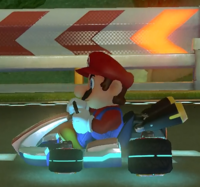
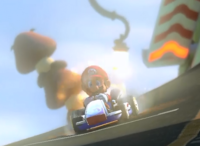
It is possible that this was the course used for rendering the demo videos in the menu, since the arrow signs there are not animated either.
ReservedXX
Unbenutzte Strecken mit den IDs von 0x02 bis 0x0F, wobei XX eine Nummer ist, ausgehend von 01 und aufwärts. Das Spiel stürzt beim Laden dieser Strecken ab.
UnderConstructionXX
Weitere unbenutzte Strecken mit den IDs von 0x30 bis 0x4F. Diese funktioneren wie ReservedXX, womit XX eine Nummer ausgehend von 01 und aufwärts ist. Das Spiel stürzt auch hier ab, wenn sie geladen werden. Wenn DLC Packs 1+2 installert wurden, laden die IDs 0x30 bis 0x42 die DLC Strecken. 0x43 bis 0x4F lassen das Spiel nach wie vor abstürzen.
Unbenutzte Modelle
Pink-farbener Toad
Es gibt einen unbenutzten, pink-farbenen Toad, welcher neben den anderen auf dem N64 Regenbogen-Boulevard gesehen werden sollte.
Früchtekorb
Dieses Modell wird intern bezeichnet als TEST_FruitBasketB. Die dafür verwendeten Texturen sind offensichtlich nur für Tests benutzt wurden, da sie nur aus Rechtecken mit einfachen Farben und Rahmen bestehen.
N64-Baum
Ein Modell namens N64Tree besteht aus einem Baum niedrigerer Qualität, ungefähr basierend auf denen von Marios Rennpiste aus Mario Kart 64. Dieses Modell unterscheidet sich deutlich von dem ähnlich benannten Modell aus Mario Kart 7, und besitzt eine andere Form als die Bäume welche auf Marios Rennpiste in Mario Kart Wii verwendet werden.
Snowless Mount Wario Tree
There is a non-snowy version of the trees everyone crashes against on Mount Wario. It is named TreeTri and correctly listed in the object table with ObjId 5019. While this model is technically used in N64 Toad's Turnpike and 3DS Wuhu Town in Mario Kart 8 Deluxe they are baked into the main model of the course, implying that this object would be once interacted with similar to other tree object counter parts that produce particle or sound effects when hit.
A similar object in appearance was later used on Hyrule Circuit as DL_TreeTri, the only main difference having different textures than of it's unused counterpart.
Yellow Pylon
While red and blue pylons/cones are seen throughout the game, there's also a yellow version which is not used on any track. It is correctly listed in the object table as PylonY (ObjId 1009).
These cones were eventually used in Mario Kart 8 Deluxe on the SNES Battle Course 1 stage.
Unused Pipes not Housing Piranha Plants
There are some pipes that are only seen in combination with a Piranha Plant. Versions without the plants exist anyway and go unused. This might implicitly tell that more pipes were once placed on track, or fewer pipes originally had plants in them.
Meant for Sweet Sweet Canyon, having a sugar frosting texture. There are 2 pipes with Piranha Plants on track. It is correctly listed in the object table as DokanCake (ObjId 1076).
Meant for Bone Dry Dunes, having a slightly muddier green. There are 2 pipes with Piranha Plants on track. It is correctly listed in the object table as DokanHone (ObjId 1105).
Start Flag
This generic start flag simply called FlagStartMario (ObjId 5024) goes unused. It looks like a modern version of the start flag used in GBA Mario Circuit, but the final version uses the classic Mario Kart font on it and slightly different coloring.
Blue Goomba
A blue Goomba named KuriboBlue, note that it seems to be an earlier model compared to the normal Goomba. It might have been intended for Piranha Plant Slide, as in MK7 the Goombas in the underground section are blue as a homage to Super Mario Brothers.
Airships
An airship model named DesertSandShip. Similar to other airship objects used in Cloudtop Cruise and Bowser's castle this object seems to have been originally intended for Bone-Dry Dunes as decoration, however lacks any animations. While ships do appear on the course they are sandships that ride on the flowing sand of the course, none appear flying in the sky. Notably the model is a direct port from Super Mario 3D Land.
A second unused airship model named Mcairship, which is the same as the others but with darker shading. From the name this airship was once used as decoration in Mario Circuit.
Early Balloon
An early balloon model with the same name as the final's, BattleBalloon. This one uses the style from the earlier games. It has an animation for all of it's colors. The early model is located in mapobj/BattleBalloon, and the final is in race_common/BattleBalloon.
Audience Group
Oddly positioned Toads and Shy Guys named CmnGroupAudience. They have bones, but no animations assigned to them.
Flat Grass Model
A flat grass model simply named Bake. Based on the texture names having "Tree64Yoshi", it was probably meant for testing bake maps using the Yoshi Valley tree.
Early Flag
An early star flag model named FlagTriangle. It has a single animation for flapping in the wind. The final model is called FlagTriangle1.
Early Trolley Gates
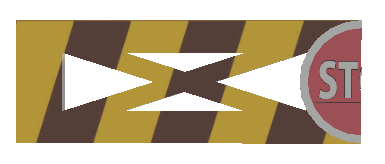
Two separate models for the Trolley toll gates at Toad Harbor named TrolleyGateLeft and TrolleyGateRight respectively. They have a single animation for opening. The final one is named TollBar.
Early Tick-Tock Clock Gears
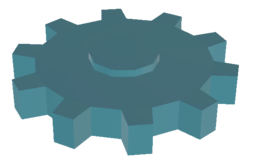
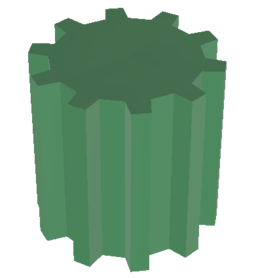
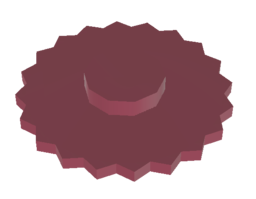
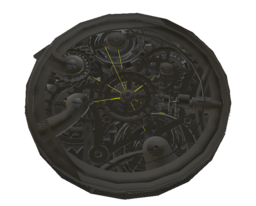
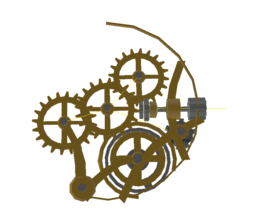
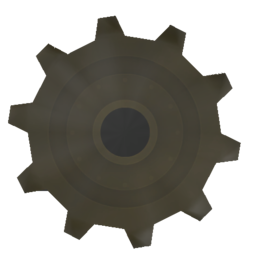
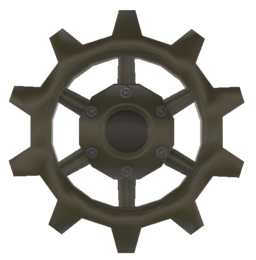
Early Tick-Tock Clock gear decorations named GearDecoA-G respectively. They all have an animation assigned to them, while GearDecoD has two animations, which seem to be a duplicate of GearDecoE's animation. The final is all in a single object in GearDeco.
Early Iceberg
An early iceberg model meant for Ice Ice Outpost named DL_IcebergA. It has a single animation for collapsing. There's another one named DL_IcebergB, but it's a duplicate of A's.
Moving Roads
A simple flat road meant for testing the wavy roads named MovingRoad. It uses a test texture with 2m written on the squares.
Another flat, longer road named MovingRoad2. This one uses a metal texture instead of the 2m texture.
A tube road most likely meant for testing a spinning road named MovingRoad3. This one uses the 2m texture.
The final moving road test named MovingRoad4. This one seems to be another spinning road test, since it does have 4 sides.
Music Piranha Plant
This Piranha Plant is meant for Music Park, however Music Park uses PackunFlower's model, but the object itself is called PackunMusic. PackunMusic's model is the piranha plant model ripped from MK7, so this one doesn't get used. It has the same animations that were used in MK7 as well.
Wii Tree
This unused tree is a higher quality version of the dancing trees from Mario Kart Wii, named WiiTree1. It has the same dancing animation from Mario Kart Wii as well. It also uses an earlier version of the bfres format.
Early SNES Rainbow Road Arrow
An early arrow meant for SNES Rainbow Road named DL_RainbowArrow. It seems like they were going to go for a more 8-bit style arrow.
Unused Koopa
An unused Koopa model named T_Nokonoko. This Koopa was meant for the Trolleys at Toad Harbor, but instead a Koopa model is included with the Trolley object. This one also has an early animation, which instead the Koopa just doesn't wave it's hands.
Early Pitcrew Toad
| Early | Final |
|---|---|
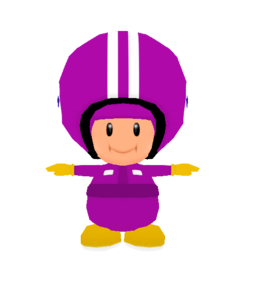 |
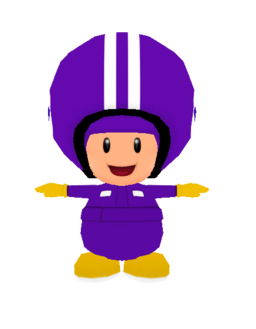 |
An early Pitcrew Toad meant for Wario Stadium named PitToadW. The color for this one represents more of Wario's overalls rather than the final's. It also doesn't open it's mouth. The final one is named PitToadWro.
Rotation Road
An unused road representing a gear model named RoadRotation1. This was most likely meant to test the rotating gears at Tick-Tock Clock.
Unused Skyboxes
There are several skyboxes which are not referenced in any track.
VRfair (ObjId 7006) is a rather generic cloudy sky, but with a weird yellow tint towards the horizon.
VRcloudSea (ObjId 7012) is the original version and now an unused duplicate of Mario Circuit's sky, with the Mario Circuit's sky containing the same original material names and textures as VRcloudSea.
VRCustomizer (ObjId 7030) is a unicolor, light blue sky. The name might suggest it was seen in a track editor as a placeholder until the real skybox was created.
While VRClock (ObjId 7034) is actually referenced in Tick-Tock Clock and Super Bell Subway, they are never seen as the track model completely encases the racers. It is a unicolor dark blue box.
VRMenu (ObjId 7025), referenced in the internally used track Gu_Menu to draw the menu background, is not rendered when used on tracks. It only consists of the reflection map which can be indirectly seen on karts in the character and parts selection screens. On tracks, it results in no skybox being drawn at all, leaving traces of models previously rendered in front of the sky. The reflection map represents an empty hall with a lot of pillars. The game uses special coding for VRMenu, since when removing or replacing it in Gu_Menu, no menu background graphics like the main menu characters or the blue backgrounds are drawn anymore, and the whole online lobby will not be rendered at all - only the UI above remains.
Additionally, there are skyboxes listed as DL_VRAnimalSpring (ObjId 7054) and DL_VRAnimalWinter (ObjId 7055) in the object dictionary. These would've obviously been used for the spring and winter seasons of the Animal Crossing track, but spring reuses VRWaterPark and winter VRSherbet instead. They either have no data or the game doesn't render them too, as placing them in a track result in the same effects as with VRMenu.
Menu Graphics
A placeholder version of the default title screen image.
A placeholder for snapshots of 16 DLC tracks to be shown as the background in Grand Prix result screens of the corresponding cups, existing in version 1.0 of the game. Named from ym_awardbg_dlc_course_00^o.bflim to ym_awardbg_dlc_course_15^o.bflim.
A placeholder snapshot of Mario Circuit for the results screen.
An unused START! icon, in game it says GO!
There are four unused cup icons. They reuse older artwork for the central objects and lack the same extra decorations that the normal icons have. Their file names refer to them as CupIconDLC00 through CupIconDLC03, indicating that these were placeholders for the DLC cups. Of the 4 released DLC cups, only the Yoshi Egg ended up getting used (albeit with a brand new icon). However, the Spiny Blue Shell also found its way into the Switch port's Booster Course Pass DLC, also with a revamped icon. These seem to imply the initial DLC was set to be more focused on purely the Mario franchise, rather than crossing over (no pun intended) with the Legend of Zelda and Animal Crossing series.
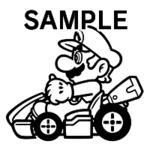
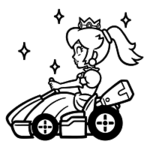
Two unused stamps. The first is a placeholder and the second is an early version of Pink Gold Peach's stamp missing the shading.
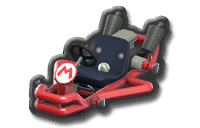
An early kart icon for the Pipe Frame. In this icon, the vehicle in question uses a design more closely resembling that seen in previous games than its final design in this one.
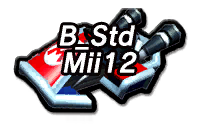
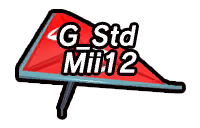
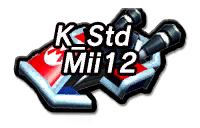
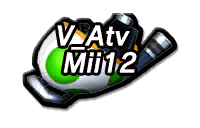

Five unused kart icons for a 13th Mii variant. The kart's variant relies on what color a player's Mii is, but there are only 12 colors to choose from. All five of the icons are placeholders using graphics from Mario Kart 7.
Icons for two planned variations of the Prancer. The Prancer is a vehicle for Peach, and since Rosalina and Daisy have alterations of Peach's vehicle parts, they were most likely planned for them. Both icons are placeholders.
Object Textures
An unused emblem for either Kamek or a generic Magikoopa. Neither appears as a playable character in the finished game or DLC packs, so he was probably scrapped during development. Kamek also appeared in pre-release screenshots of Mario Kart 64 (then called "Super Mario Kart R").
Kamek would go on to join the playable roster of Mario Kart Tour, where he does indeed use this emblem.
A generic emblem with the logo eight is included in the emblem folder, but goes unused. It is indirectly seen in pre-rendered graphics for the kart previews.
A placeholder texture for kart emblems found inside most kart model files.
Lakitu contains a texture showing a final lap or section 2 (hence the 2 is golden), but the final game always displays the 3/3 board for the last lap or section, no matter the number of total laps (except for 7 laps which it handles correctly to support Baby Park). However, during E3 2013, there were Mario Kart 8 demos in which people could try out Mario Kart 8 before its release - all races that were in the demo only had two laps, which required the use of this graphic.
In version 2.0, until version 4.0, Lakitu had placeholder lap graphics for 5 laps, using a basic font, most likely for testing. These do actually appear if a track is set to 5 laps in version 2.0 and 3.0, until GCN Baby Park was added in 4.0, which added the 7 lap graphics instead. 5 laps was also the limit in this version. Anything higher would crash the game when crossing the finish line.

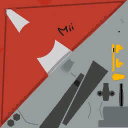
Crude textures made for the Standard Mii Glider. Both colors were dependent on which sex the Mii was; blue for female and red for male.
Unbenutzte Kart-Embleme
Ein unbenutztes Emblem für Kamek (oder einen unbenannten Magikoopa). Magikoopa/Kamek erscheint weder im fertigen Spiel noch in den DLC-Erweiterungen als spielbarer Charakter, daher ist anzunehmen, dass er während der Entwicklung verworfen wurde.
Ein generisches Emblem mit der Logo-Acht befindet sich im Emblem-Ordner, wird aber nicht verwendet. Es ist indirekt in den vorgerenderten Kart-Grafiken zu sehen.
Eine Platzhalter-Textur für Kart-Embleme, die in den meisten Kart-Modelldateien vorhanden ist.
The internally used track Gu_Menu actually consists of a finite small plane on which karts are placed at race start, which is also correctly textured with a test texture. This plane is not visible when running the track as the material defines to cull both back and front faces rather than only back faces. Together with no skybox being added as an object, only drawing artifacts are visible around racers.
A placeholder signboard texture found alongside a number of other signboard textures for the Excitebike track. The text on the bottom left translates to "※4:1 Non-Sign Logo Variation".
Unbenutzte/Test-Items
Test-Items
In der Itemslot-Tabelle ItemSlotTable.byaml gibt es zwei Test-Einträge namens Test3 und Test4. Höchstwahrscheinlich sind dies übriggebliebene Einträge der gleich-benannten Items aus Mario Kart 7#Test Items (womit auch diese keinerlei Funktionalität aufweisen).
Glückssieben-Überbleibsel
In der Itemslot-Tabelle ItemSlotTable.byaml gibt es einen Eintrag namens Seven (Sieben). Es ist vermutlich ein Überbleibsel für das Testen der Wunderacht während der Entwicklung und es wurde nur vergessen, den Namen zu ändern.
Fake Item Box Leftover
In the file RaceLogData.exbin, appears the text "FakeBox" as well as all other known cut items. Since it is only referred to in that file, players can assume that they cut it really early in development.
Super Leaf Leftover
In the file RaceLogData.exbin, appears the text "Tail" as well as all other known cut items. Since it is only referred to in that file, players can assume that they cut it really early in development.
Disabled Glider Closing
Glider closing with B button from Mario Kart 7 is present in Mario Kart 8/Deluxe but it is not possible to perform because the game clears the B button input when in a glider. By removing this check, the glider can be closed by pressing B, showing that the function is left in the game and working perfectly, but not performable because of the input clear. This was discovered by Marioiscool246, who also made the cheat code to enable this feature back.
Shy Guy Bazaar
In version 2.0 of the game, present in AICourseTable_GP.byaml and AICourseTable_VS.byaml, as well as the game's code, is references for Shy Guy Bazaar (D3ds_SandTown). Shy Guy Bazaar was most likely planned to be DLC in favor of Neo Bowser City, but didn't get that far in development, since it's only a few references. All of the DLC tracks were also present in the code at this time as well, except for the seasonal Animal Crossing tracks, being only Du_Animal.
Regionale Unterschiede
Wie bei Mario Kart 7 auch besitzen viele Strecken und Fahrzeugteile unterschiedliche Namen in den verschiedenen Versionen:
Streckennamen
Die Streckennamen sind größtenteils die gleichen in Japanisch und Englisch (abgesehen von der Standard-Lokalisierung). Retro-Strecken besitzen die gleichen Namensänderungen wie in dem Spiel aus dem sie stammen. Die Instrumentalpiste wird z.B. in der amerikanischen Version Music Park genannt, in der europäischen englischen Version Melody Motorway. Die Animal Crossing-Strecken benutzen in der japanischen Version auch den japanischen Titel des Spiels.
| Japanisch | Europäisch | Amerikanisch |
|---|---|---|
| Sweets Canyon (スイーツキャニオン) | Sweet Sweet Canyon | Sweet Sweet Canyon |
| Toad Harbor (キノピオハーバー) | Toad Harbour | Toad Harbor |
| Shy Guy Mine (ヘイホーこうざん) | Shy Guy Falls | Shy Guy Falls |
| Dolphin Cape (ドルフィンみさき) | Dolphin Shoals | Dolphin Shoals |
| Electro Dream (エレクトロドリーム) | Electrodrome | Electrodrome |
| Wario Snow Mountain (ワリオスノーマウンテン) | Mount Wario | Mount Wario |
| Sky Garden (スカイガーデン) | Cloudtop Cruise | Cloudtop Cruise |
| Bone Bone Desert (ホネホネさばく) | Bone Dry Dunes | Bone-Dry Dunes |
| Koopa Castle (クッパキャッスル) | Bowser's Castle | Bowser's Castle |
| Moo Moo Country (モーモーカントリー) | Moo Moo Meadows | Moo Moo Meadows |
| Kinopio Highway (キノピオハイウェイ) | Toad's Turnpike | Toad's Turnpike |
| Crispy Desert (カラカラさばく) | Dry Dry Desert | Dry Dry Desert |
| Donut Plain 3 (ドーナツへいや3) | Donut Plains 3 | Donut Plains 3 |
| Peach Circuit (ピーチサーキット) | Royal Raceway | Royal Raceway |
| Music Park (ミュージックパーク) | Melody Motorway | Music Park |
| Tick TaClock (チックタックロック) | Tick-Tock Clock | Tick-Tock Clock |
| Piranha Slider (パックンスライダー) | Piranha Plant Pipeway | Piranha Plant Slide |
| Rumbling Volcano (グラグラかざん) | Grumble Volcano | Grumble Volcano |
| Excitebike (エキサイトバイク) | Excitebike Arena | Excitebike Arena |
| Dragon Road (ドラゴンロード) | Dragon Driftway | Dragon Driftway |
| Slippery Twister (ツルツルツイスター) | Ice Ice Outpost | Ice Ice Outpost |
| Wario Mine (ワリオこうざん) | Wario's Gold Mine | Wario's Gold Mine |
| Nature Road (ネイチャーロード) | Wild Woods | Wild Woods |
| Doubutsu no Mori (どうぶつの森) | Animal Crossing | Animal Crossing |
| Neo Koopa City (ネオクッパシティ) | Koopa City | Neo Bowser City |
| Ring Ring Metro (リンリンメトロ) | Super Bell Subway | Super Bell Subway |
An odd oversight as a result of this is that the signs in the European versions of "Music Park" and "Neo Bowser City" still use their American names.
Retro-System
Die mit Mario Kart DS eingeführte Namensgebungs-Tradition wird weitergeführt, daher gibt es kleine Unterschiede in den japanischen und anderen Versionen bei den Initialen, die angeben, aus welchem Retro-System die Strecke stammt.
| Japanisch | International |
|---|---|
| SFC | SNES |
| GC | GCN |
Fahrzeugkörper
| Japanisch | Europäisch | Amerikanisch |
|---|---|---|
| Skeleton (スケルトン) | Pipe Frame | Pipe Frame |
| G Force (Gフォース) | Mach 8 | Mach 8 |
| Steel Diver (スティールダイバー) | Steel Driver | Steel Driver |
| Cat Classical (ネコクラシカル) | Cat Cruiser | Cat Cruiser |
| Turbo One (ターボ・ワン) | Circuit Special | Circuit Special |
| Tri-Mush (トライマッシュ) | Tri-Speeder | Tri-Speeder |
| Beat Demon (ビートデイモン) | Badwagon | Badwagon |
| Princess Coach (プリンセスコーチ) | Prancer | Prancer |
| Pata Tenten (パタテンテン) | Buggybud | Biddybuggy |
| Koopa Ship (クッパシップ) | Landship | Landship |
| Sneakart (スニーカート) | Bounder | Sneeker |
| Superstar (スーパースター) | Sports Coupé | Sports Coupe |
| Gold Kart (ゴールドカート) | Gold Kart | Gold Standard |
| Super Comet (スーパーコメット) | Comet | Comet |
| Mach GP (マッハGP) | Sport Bike | Sport Bike |
| Maximum (マキシマム) | The Duke | The Duke |
| Burning Bowl (バーニングボウル) | Flame Rider | Flame Rider |
| Moto-Dozer (モト・ドーザー) | Varmint | Varmint |
| Soramame (そらまめ) | Mr Scooty | Mr. Scooty |
| Jet Rider (ジェットライダー) | Jet Bike | Jet Bike |
| Standard ATV (スタンダードATV) | Standard Quad | Standard ATV |
| Hana-chan Buggy (ハナチャンバギー) | Wild Wiggler | Wild Wiggler |
| Kuma Ride (くまライド) | Teddy Buggy | Teddy Buggy |
| Tanuki Buggy (タヌキバギー) | Tanooki Kart | Tanooki Kart |
| B Dash (Bダッシュ) | B Dasher | B Dasher |
| Wakuwaku Beetle (わくわくビートル) | Streetle | Streetle |
| Kisekae Scooter (きせかえスクーター) | City Tripper | City Tripper |
| Bowser Trike (バウザートライク) | Bone Rattler | Bone Rattler |
Die japanische Version nennt diese Teile weiterhin frame anstelle von body.
Reifen
| Japanisch | Europäisch | Amerikanisch |
|---|---|---|
| Normal Tire (ノーマルタイヤ) | Normal | Standard |
| Wild Tire (ワイルドタイヤ) | Monster | Monster |
| Roller Tire (ローラータイヤ) | Roller | Roller |
| Ring Tire (リングタイヤ) | Slim | Slim |
| Slick Tire (スリックタイヤ) | Slick | Slick |
| Metal Tire (メタルタイヤ) | Metal | Metal |
| Button Tire (ボタンタイヤ) | Button | Button |
| Block Tire (ブロックタイヤ) | Off-Road | Off-Road |
| Sponge Tire (スポンジタイヤ) | Sponge | Sponge |
| Wood Ring (ウッドリング) | Wooden | Wood |
| Cushion Tire (クッションタイヤ) | Cushion | Cushion |
| Normal Blue (ノーマルブルー) | Normal Blue | Blue Standard |
| Wild Hot (ワイルドホット) | Funky Monster | Hot Monster |
| Sky Roller (スカイローラー) | Azure Roller | Azure Roller |
| Spicy Ring (スパイシーリング) | Crimson Slim | Crimson Slim |
| Cream Block (クリームブロック) | Retro Off-Road | Retro Off-Road |
| Gold Tire (ゴールドタイヤ) | Gold Wheels | Gold Tires |
| GLA Tire (GLAタイヤ) | GLA Wheels | GLA Tires |
| Triforce Tire (トライフォースタイヤ) | Triforce Tyres | Triforce Tires |
| Leaf Tire (リーフタイヤ) | Leaf Tyres | Leaf Tires |
Die europäische Version nennt diese Teile wheel anstelle von tire.
Fallschirme
| Japanisch | Englisch |
|---|---|
| Super Kite (スーパーカイト) | Super Glider |
| Billowing Balloon (もくもくバルーン) | Cloud Glider |
| Wario Kite (ワリオカイト) | Wario Wing |
| Zunguri Kite (ズングリカイト) | Waddle Wing |
| Flower Kite (フラワーカイト) | Flower Glider |
| Koopa Kite (クッパカイト) | Bowser Kite |
| Sailplane (セイルプレーン) | Plane Glider |
| Parafoil MKTV (パラフォイルMKTV) | MKTV Parafoil |
| Gold Kite (ゴールドカイト) | Gold Glider |
| Hyrule Kite (ハイラルカイト) | Hylian Kite |
| Paper Airplane (かみひこうき) | Paper Glider |
Anderes
Es gibt einige weitere regionale unterschiede in anderen Teilen des Spiels, wie z.B. Menütext oder Chat-Makros, bei denen u.A. lokaler Slang entfernt wurde um die Übersetzung zu vereinfachen.
| Text | Europäisch | Amerikanisch |
|---|---|---|
| 200cc-Modus-Beschreibung | Super fast - braking is crucial! | CRAZY FAST! Braking is crucial. |
| Chat-Makro | So unfair! | Not fair! |
| Chat-Makro | I'm using motion controls! | I'm using tilt controls! |
| Chat-Makro | I'm heading off... | I'm outta here. |
| Chat-Makro | Thanks very much! | Thank you! |
| Chat-Makro | Good night! | Goodnight! |
Versionsunterschiede
Version 2.0
Das Update auf Version 2.0 wurde am 27. August 2014 veröffentlicht, mit folgenden Funktionen:
- Fügt einen Shop-Button zum Hauptmenü hinzu um herunterladbare Inhalte zu bestellen oder herunterzuladen.
- Fügt einen Statistik-Button zum Hauptmenü hinzu über den die Spieler die Anzahl eingesammelter Münzen, Gewonnen-Verloren-Zähler, favorisierte Kurse und Charaktere sowie die Anzahl an Boosts, Super-Boosts etc. ablesen können.
- Fügt die Möglichkeit hinzu, die Übersichtskarte des Kurses auf dem Fernsehbildschirm durch Drücken der Minus-Taste ("-") auf dem Wii U-Gamepad sichtbar zu machen.
- Ändert die Reihenfolge der Menüoptionen nach Ende eines Rennens, sodass "Nächstes Rennen" an erster Stelle steht, anstelle der Höhepunkt-Wiederholung. Desweiteren wird die zuvor gewählte Option gemerkt und beim nächsten Rennende automatisch ausgewählt.
- Speichert die zuvor gewählte Fahrzeugkonfiguration des Spielers, sodass diese auch nach Aus- und Wiedereinschalten Wii U vorausgewählt wird.
- Erhöht das Limit der maximalen Online-Punkte auf 99999 anstelle von 9999.
- Verbesserte Stabilität bei Online-Rennen und -Schlachten, sowie einige weitere Fehlerkorrekturen für ein verbessertes Spielerlebnis.
Dieses Update veränderte auch die Verteilung von Punkten in Online-Rennen: der minimal benötigte Platz um Punkte zu erhalten wurde für Spieler mit viel Punkten deutlich erhöht, möglicherweise um die Inflation von Punkten zu verhindern. (Diese Änderung wurde mit Version 3.0 wieder rückgängig gemacht).
Mit Version 2.0 wird die Auswahl einer Zufallsstrecke nicht eine der 3 zur Auswahl stehenden Strecken ergeben.
Version 3.0
Version 3.0 wurde am 13. November 2014 mit folgenden Funktionen veröffentlicht. Dieser Patch wurde für Online-Spiele benötigt.
- Fügt die DLC-Charaktere Tanuki-Mario, Katzen-Peach und Link hinzu, sowie die Strecken des Ei- und Triforce-Cups zur Auswahl in Online-Spielen, wenn DLC-Paket 1 gekauft wurde. Eine Option wurde hinzugefügt um online mit oder ohne heruntergeladene Strecken zu spielen, allerdings gibt es eine solche Option für heruntergeladene Charaktere nicht.
- Vorhersehend wird Amiibo-Funktionalität mit einem dazugehörigen Symbol im Hauptmenü implementiert (die erste Welle an Amiibos wurde erst am 21. November veröffentlicht). Mit dieser Funktion können Spieler Rennanzüge für ihre Miis freischalten, indem sie eine kompatible Amiibo-Figur auf dem NFC-Bereich des Gamepads platzieren. Das Mii-Icon in der Charakterauswahl wurde dementsprechend angepasst.
- Behebt einige Spielbalance-Probleme sowie weitere Fehler für ein besseres Spielerlebnis.
Dieses Update machte die Änderungen am Punktesystem rückgängig und folgt nun wieder einem System ähnlich der Version 1.0, damit Spieler mit vielen Punkten diese wieder einfacher erhalten können.
Version 4.0
Das Update auf Version 4.0 wurde am 23. April 2015 veröffentlicht.
- Fügt die DLC-Charaktere Bewohner/Bewohnerin, Melinda und Knochenbowser hinzu, sowie Strecken des Crossing- und Glocken-Cups zur Auswahl in Online-Spielen, sobald DLC-Paket 2 gekauft wurde.
- Fügt 200cc als auswählbare Klasse hinzu.
- Fügt neue Amiibo-basierte Rennanzüge für Bowser-, Sonic-, Bewohner-/Bewohnerin-, Mega Man-, Rosalina- und Toad-Amiibos hinzu, sowie voraussehend für Olimar, Wario und Pac-Man, welche später veröffentlicht wurden.
- Weitere Miiverse-Stempel wurden hinzugefügt.
Version 4.1
Version 4.1 wurde kurz darauf am 1. Mai 2015 veröffentlicht, welches die Spiegel- und 200cc-Klassen entsperrt auch wenn diese noch nicht freigespielt wurden. Desweiteren gibt es einige Fehlerkorrekturen.
Totakas Lied
Eine kurze Erkennungsmelodie von Kazumi Totaka ist in so gut wie jedem Spiel enthalten, für das er Musik komponiert hat. Einige Strecken beinhalten Yoshis welche den Rennfahrern zujubeln, wobei es eine kleine Chance gibt, dass diese Totakas Lied summen (da Totaka auch der Synchronsprecher für Yoshis ist). Damit dies nicht sofort bemerkbar ist, wird es in einer geringen Lautstärke abgespielt, wodurch es schnell von der Hintergrundmusik übertönt wird. Die Animationen der Yoshis werden zu jedem Rennstart zufällig ausgewählt. Es kann nicht in MKTV-Replays gehört werden; nur während eines Rennens.
| Strecke | Wo das Lied gehört werden kann (Orte werden zufällig ausgewählt) |
|---|---|
| Zuckersüßer Canyon | Einer der Yoshis im Startbereich, oder direkt in der Nähe des Hauses wo beide Streckenteile wieder zusammengeführt werden. |
| GBA Marios Piste | Einer der Yoshis in der Nähe des Pitstops. |
| SNES Donut-Ebene 3 | Einer der Yoshis, welche auf den Blöcken steht. |
| N64 Yoshi-Tal | Einer der Yoshis in der Nähe des Zaunes im Startbereich. |
| GCN Yoshis Piste (DLC-Paket 1) | Einer der Yoshis im Startbereich oder im Tunnel. |
| GCN Baby-Park (DLC-Paket 2) | Einer der jubelnden Yoshis in der Nähe der Ecken oder Mitte des Tracks. |
| Marios Metro (DLC-Paket 2) | Einer der jubelnden Yoshis im Startbereich. |
| To do: Nachdem so viele Orte im Original-Spiel und DLC-Paket 1 gefunden wurden, gibt es definitiv noch einige weitere Orte, die im DLC-Paket 2 geprüft werden sollten; z.B. die Animal Crossing-Strecken (K. K. Slider könnte es singen), sowie die Möglichkeit das Bewohner/Bewohnerin und Melinda es nach einigem Leerlauf summen. |
Oddities
Revision Files
Beyond the base game, there are two files going by resourcerev.dat and srcrev.dat, these appear to be copied over accidentally from the stripped debug directory of the final game, they appear to contain the revision of the game data and source files.
| srcrev.dat | resourcerev.dat |
|---|---|
129722 |
129724 |
Since these are revision numbers and not unique hashes for a specific commit, it is likely that Nintendo was using Apache Subversion as their version control for Mario Kart 8.
DLC Placeholders
In DLC directories, excluding 13, 15, 17 and 19, there are some text files with no data at all, possibly to help the developers note what DLC would go here if any were added.
course_dummy.txt
course dummy file.
course_permission.txt
course permission file.
dl_permission.txt
have a permission.
dl_reservation.txt
have a reservation.
Trivia der Charakter-Audiodateien
Die Stimmen der meisten Charaktere basiert größtenteils aus Aufnahmen von früheren Spielen. Charaktere wie Mario, Luigi und Wario haben sauberere Aufnahmen ihrer Mario Kart 64-Stimmen, hauptsächlich beim Boosten und Durchführen von Tricks. Tanuki-Mario andererseits besitzt Aufnahmen aus einer handvoll anderer Mario-Spiele, wie beispielsweise Super Mario Advance und Super Mario Sunshine. Die Entwickler behielten sogar den Namen des Original-Spiels in den Dateinamen bei, wo möglich: z.B. Kart64 für Mario Kart 64.
Interner Projektname
Die ausführbare Datei des Spiels heißt Turbo.rpx. Wie auch bei Super Mario 3D World wird in einigen weiteren Dateien das Spiel mit diesem Namen erwähnt.
- Pages missing developer references
- Games developed by Nintendo EAD
- Games developed by Bandai Namco
- Pages missing publisher references
- Games published by Nintendo
- Pages missing date references
- Games with unused areas
- Games with unused graphics
- Games with unused models
- Games with regional differences
- Games with revisional differences
- To do
- Mario series
Cleanup > Pages missing date references
Cleanup > Pages missing developer references
Cleanup > Pages missing publisher references
Cleanup > To do
Games > Games by content > Games with regional differences
Games > Games by content > Games with revisional differences
Games > Games by content > Games with unused areas
Games > Games by content > Games with unused graphics
Games > Games by content > Games with unused models
Games > Games by developer > Games developed by Bandai Namco
Games > Games by developer > Games developed by Nintendo > Games developed by Nintendo EPD > Games developed by Nintendo EAD
Games > Games by publisher > Games published by Nintendo
Games > Games by series > Mario series
